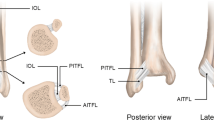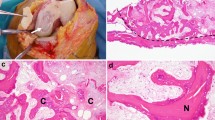Abstract
Objective
To evaluate the significance of plantar talar head injury (PTHI) in predicting osseous and soft tissue injuries on ankle MRI.
Materials and methods
The IRB approved this HIPAA-compliant retrospective study. The study group consisted of 41 ankle MRIs with PTHI that occurred at our institution over a 5 ½ year period. Eighty MRIs with bone injuries in other locations matched for age, time interval since injury, and gender formed a control group. Injuries to the following structures were recorded: medial malleolus, lateral malleolus/distal fibula, posterior malleolus, talus, calcaneus, navicular, cuboid, lateral, medial and syndesmotic ligaments, spring ligament complex, and extensor digitorum brevis (EDB) muscle. Twenty separate logistic regressions determined which injuries PTHI predicted, using the Holm procedure to control for family-wise alpha at 0.05.
Results
PTHI strongly predicted the occurrence of injuries involving the anterior process of the calcaneus [24 % of cases, odds ratio (OR) 12.66], plantar components of the spring ligament (27 %, OR 9.43), calcaneal origin of the EDB and attachment of the dorsolateral calcaneocuboid ligament (22 %, OR 7.22), cuboid (51 %, OR 6.58), EDB (27 %, OR 5.49), anteromedial talus (66 %, OR 4.78), and posteromedial talus (49 %, OR 4.48). PTHI strongly predicted lack of occurrence of syndesmotic ligament injury (OR 19.6). The PTHI group had a high incidence of lateral ligamentous injury (78 %), but not significantly different from the control group (53 %).
Conclusions
PTHI is strongly associated with injury involving the transverse tarsal joint complex. We hypothesize it results from talo-cuboid and/or talo-calcaneal impaction from a supination injury of the foot and ankle.




Similar content being viewed by others
References
Rios AM, Rosenberg ZS, Bencardino JT, Rodrigo SP, Theran SG. Bone marrow edema patterns in the ankle and hindfoot: distinguishing MRI features. AJR Am J Roentgenol. 2011;197(4):W720–9.
Nishimura G, Yamato M, Togawa M. Trabecular trauma of the talus and medial malleolus concurrent with lateral collateral ligamentous injuries of the ankle: evaluation with MR imaging. Skelet Radiol. 1996;25(1):49–54.
Labovitz JM, Schweitzer ME. Occult osseous injuries after ankle sprains: incidence, location, pattern, and age. Foot Ankle Int. 1998;19(10):661–7.
Sijbrandij ES, van Gils AP, Louwerens JW, de Lange EE. Posttraumatic subchondral bone contusions and fractures of the talotibial joint: occurrence of “kissing” lesions. AJR Am J Roentgenol. 2000;175(6):1707–10.
Zanetti M, De Simoni C, Wetz HH, Zollinger H, Hodler J. Magnetic resonance imaging of injuries to the ankle joint: can it predict clinical outcome? Skelet Radiol. 1997;26(2):82–8.
Pinar H, Akseki D, Kovanlikaya I, Araç S, Bozkurt M. Bone bruises detected by magnetic resonance imaging following lateral ankle sprains. Knee Surg Sports Traumatol Arthrosc. 1997;5(2):113–7.
Longo UG, Loppini M, Romeo G, van Dijk CN, Maffulli N, Denaro V. Bone bruises associated with acute ankle ligament injury: do they need treatment? Knee Surg Sports Traumatol Arthrosc. 2013;21(6):1261–8.
Brown KW, Morrison WB, Schweitzer ME, Parellada JA, Nothnagel H. MRI findings associated with distal tibiofibular syndesmosis injury. AJR Am J Roentgenol. 2004;182(1):131–6.
Cromeens B, Patterson R, Sheedlo H, Motley TA, Stewart D, Fisher C, et al. Association of hindfoot ligament tears and osteochondral lesions. Foot Ankle Int. 2011;32(12):1164–74.
Yammine K, Fathi Y. Ankle “sprains” during sport activities with normal radiographs: Incidence of associated bone and tendon injuries on MRI findings and its clinical impact. Foot (Edinb). 2011;21(4):176–8.
Alanen V, Taimela S, Kinnunen J, Koskinen SK, Karaharju E. Incidence and clinical significance of bone bruises after supination injury of the ankle. A double-blind, prospective study. J Bone Joint Surg (Br). 1998;80(3):513–5.
Langner I, Frank M, Kuehn JP, et al. Acute inversion injury of the ankle without radiological abnormalities: assessment with high-field MR imaging and correlation of findings with clinical outcome. Skelet Radiol. 2011;40(4):423–30.
Khor YP, Ken JT. The anatomic pattern of injuries in acute inversion ankle sprains: a magnetic resonance imaging study. Orthop J Sports Med. 2013;1(7).
Chan VO, Moran DE, Shine S, Eustace SJ. Medial joint line bone bruising at MRI complicating acute ankle inversion injury: what is its clinical significance? Clin Radiol. 2013;68(10):e519–23.
Kavanagh EC, Koulouris G, Gopez A, Zoga A, Raikin S, Morrison WB. MRI of rupture of the spring ligament complex with talo-cuboid impaction. Skelet Radiol. 2007;36(6):555–8.
Long NM, Zoga AC, Kier R, Kavanagh EC. Insufficiency and nondisplaced fractures of the talar head: MRI appearances. AJR Am J Roentgenol. 2012;199(5):W613–7.
Desai KR, Beltran LS, Bencardino JT, Rosenberg ZS, Petchprapa C, Steiner G. The spring ligament recess of the talocalcaneonavicular joint: depiction on MR images with cadaveric and histologic correlation. AJR Am J Roentgenol. 2011;196(5):1145–50.
Resnick D. In: Resnick D, Heung SK, Pretterklieber ML, editors. Internal derangements of joints. 2nd ed. Philadelphia: Elsevier, Inc; 2007. p. 259–370.
Robbins MI, Wilson MG, Sella EJ. MR imaging of anterosuperior calcaneal process fractures. AJR Am J Roentgenol. 1999;172(2):475–9.
Ouellette H, Salamipour H, Thomas BJ, Kassarjian A, Torriani M. Incidence and MR imaging features of fractures of the anterior process of calcaneus in a consecutive patient population with ankle and foot symptoms. Skelet Radiol. 2006;35(11):833–7.
Norfray JF, Rogers LF, Adamo GP, Groves HC, Heiser WJ. Common calcaneal avulsion fracture. AJR Am J Roentgenol. 1980;134(1):119–23.
Williams G, Widnall J, Evans P, Platt S. MRI features most often associated with surgically proven tears of the spring ligament complex. Skelet Radiol. 2013;42(7):969–73.
Ting AY, Morrison WB, Kavanagh EC. MR imaging of midfoot injury. Magn Reson Imaging Clin N Am. 2008;16(1):105–15.
Melão L, Canella C, Weber M, Negrão P, Trudell D, Resnick D. Ligaments of the transverse tarsal joint complex: MRI-anatomic correlation in cadavers. AJR Am J Roentgenol. 2009;193(3):662–71.
Renfrew DL, el-Khoury GY. Anterior process fractures of the calcaneus. Skelet Radiol. 1985;14(2):121–5.
Renstrom P, Wertz M, Incavo S, Pope M, Ostgaard HC, Arms S, et al. Strain in the lateral ligaments of the ankle. Foot Ankle. 1988;9(2):59–63.
Sormaala MJ, Niva MH, Kiuru MJ, Mattila VM, Pihlajamäki HK. Bone stress injuries of the talus in military recruits. Bone. 2006;39(1):199–204.
Elias I, Zoga AC, Raikin SM, Peterson JR, Besser MP, Morrison WB, et al. Bone stress injury of the ankle in professional ballet dancers seen on MRI. BMC Musculoskelet Disord. 2008;9:39.
Umans H, Pavlov H. Insufficiency fracture of the talus: diagnosis with MR imaging. Radiology. 1995;197(2):439–42.
Trnka HJ, Zettl R, Ritschl P. Fracture of the anterior superior process of the calcaneus: an often misdiagnosed fracture. Arch Orthop Trauma Surg. 1998;117(4–5):300–2.
Author information
Authors and Affiliations
Corresponding author
Ethics declarations
Conflict of interest
The authors declare that they have no conflict of interest.
Rights and permissions
About this article
Cite this article
Gorbachova, T., Wang, P.S., Hu, B. et al. Plantar talar head contusions and osteochondral fractures: associated findings on ankle MRI and proposed mechanism of injury. Skeletal Radiol 45, 795–803 (2016). https://doi.org/10.1007/s00256-016-2358-y
Received:
Revised:
Accepted:
Published:
Issue Date:
DOI: https://doi.org/10.1007/s00256-016-2358-y




